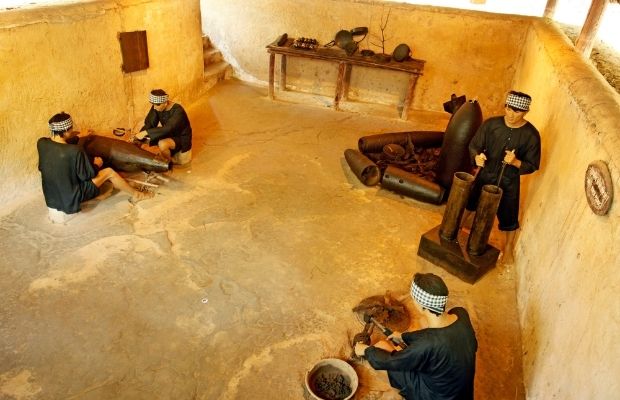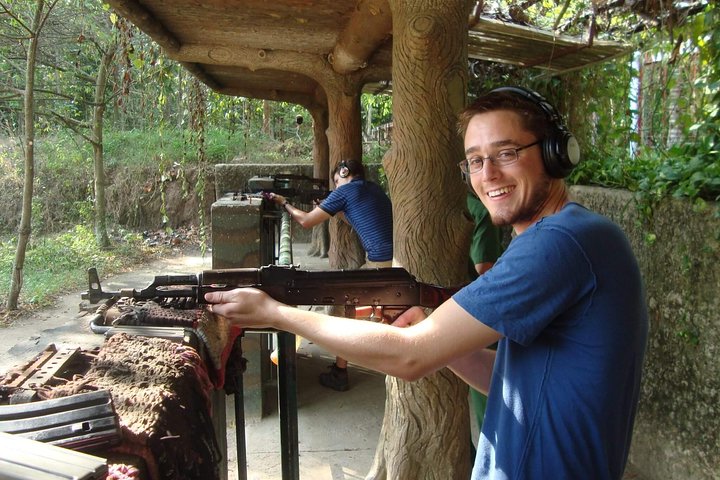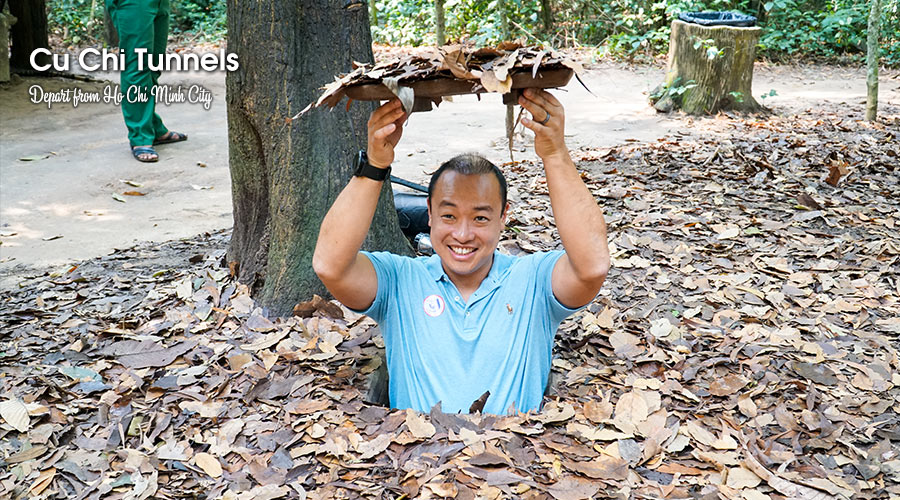Table of Contents
Nestled in the heart of Southern Vietnam, the Cu Chi Tunnels Vietnam war stand as a testament to the ingenuity, resilience, and determination of the Vietnamese people during the Vietnam War. Stretching for a mind-boggling 250 kilometers (155 miles), these subterranean passageways played a pivotal role in the protracted conflict, becoming a symbol of Vietnamese resistance and contributing significantly to the outcome of the war.
History of Cu Chi Tunnels during Vietnam War

The origins of the Cu Chi Tunnels Vietnam war can be traced back to the early 1940s when they were initially constructed as a network of hideouts and communication routes for Vietnamese revolutionaries fighting against French colonial rule. However, it was during the Vietnam War that the tunnels gained widespread recognition for their strategic importance and became an integral part of the Viet Cong’s resistance against American and South Vietnamese forces.
The Rise of the Viet Cong
The Viet Cong, or the National Liberation Front (NLF), was a communist guerrilla organization formed in 1960 with the aim of overthrowing the South Vietnamese government and reuniting the country under a communist regime. They were supported by North Vietnam and received training, weapons, and supplies from their communist allies.
As the conflict escalated, the Viet Cong grew in strength and numbers, gaining control over large parts of rural South Vietnam. They used guerrilla tactics and unconventional warfare to fight against the better-equipped and technologically advanced American and South Vietnamese armies.
The Role of Cu Chi Tunnels Vietnam war
The Cu Chi Tunnels were strategically located in the Cu Chi district, just 40 kilometers (25 miles) northwest of Saigon (now Ho Chi Minh City). This location made them an ideal base for the Viet Cong to launch attacks on the capital city and its surrounding areas.
The tunnels served as a sanctuary for the Viet Cong, allowing them to evade enemy detection, survive relentless bombing campaigns, and launch surprise attacks on American and South Vietnamese forces. The Viet Cong’s mastery of tunnel warfare proved instrumental in their ability to inflict heavy casualties on the enemy while minimizing their own losses.
Strategic Importance of Cu Chi Tunnels in Vietnam War

The Cu Chi Tunnels played a crucial role in the Vietnam War, providing the Viet Cong with a strategic advantage over their enemies. Here are some key reasons why the tunnels were so important:
Concealment and Protection
The dense jungle cover and intricate network of tunnels provided the Viet Cong with excellent concealment and protection from enemy attacks. The tunnels were camouflaged with leaves and branches, making them almost invisible to aerial surveillance. This allowed the Viet Cong to move freely and carry out operations without being detected by the enemy.
Moreover, the tunnels were designed to withstand heavy bombing and shelling, providing the Viet Cong with a safe haven during intense battles. They were also equipped with air vents and trapdoors, allowing the Viet Cong to breathe and escape in case of an attack.
Mobility and Communication
The tunnels were not just used for hiding and protection; they also served as a means of communication and transportation for the Viet Cong. The narrow passageways were used to relay messages, transfer supplies, and move troops between different parts of the country. This enabled the Viet Cong to coordinate their attacks and maintain their stronghold in various regions.
Surprise Attacks
One of the most significant advantages of the Cu Chi Tunnels Vietnam war was their ability to facilitate surprise attacks on the enemy. The Viet Cong would emerge from the tunnels, launch an attack, and then quickly disappear back into the underground network, leaving the enemy confused and disoriented. This tactic proved highly effective in catching the enemy off guard and inflicting heavy casualties.
Construction and Design of Cu Chi Tunnels

The construction and design of the Cu Chi Tunnels Vietnam war were a remarkable feat of engineering, considering the limited resources and technology available to the Viet Cong. The tunnels were dug by hand using simple tools such as shovels, hoes, and bamboo picks. The soil was then carried away in baskets and dumped in nearby rivers or fields to avoid detection.
Three Levels of Tunnels
The Cu Chi Tunnels were divided into three levels: the upper level, the middle level, and the lower level. The upper level was just below the surface and consisted of small, narrow tunnels used for ventilation and escape routes. The middle level was deeper underground and served as living quarters, storage areas, and meeting rooms. The lower level was the deepest and most secure, housing hospitals, kitchens, and weapons factories.
Booby Traps and Defense Mechanisms
To protect themselves from enemy attacks, the Viet Cong set up numerous booby traps and defense mechanisms throughout the tunnels. These included tripwires, punji stick traps, and hidden pits filled with sharp bamboo spikes. The Viet Cong also used fake tunnel entrances to lure the enemy into traps and ambushes.
Life Inside the Cu Chi Tunnels during Vietnam War

Life inside the Cu Chi Tunnels was extremely challenging and dangerous for the Viet Cong soldiers. They had to endure cramped and dark conditions, constant fear of being discovered, and the risk of disease and injury. However, the Viet Cong were determined to fight for their cause and were willing to make sacrifices to achieve victory.
Living Conditions
The living conditions inside the tunnels were harsh and primitive. The soldiers had to sleep on bamboo beds or hammocks, often sharing them with insects and rodents. The air was thick with humidity and smoke from cooking fires, making it difficult to breathe. The lack of natural light and fresh air also took a toll on the soldiers’ physical and mental health.
Food and Supplies
The Viet Cong had to rely on limited food supplies, mostly consisting of rice, vegetables, and fish caught from nearby rivers. They also had to be resourceful and make use of whatever they could find in the jungle, such as wild fruits and animals. The soldiers were constantly on the move, making it difficult to stockpile supplies and forcing them to live off the land.
Health and Hygiene
The unsanitary conditions inside the tunnels posed a significant health risk for the soldiers. Many suffered from skin diseases, respiratory problems, and infections due to poor hygiene and lack of medical facilities. The Viet Cong had to rely on traditional medicines and herbs to treat their ailments, and many died from preventable diseases.
Tactics and Operations of Viet Cong in Cu Chi Tunnels Vietnam war

The Viet Cong used a variety of tactics and operations to defend and expand their territory in and around the Cu Chi Tunnels. These included guerrilla warfare, sabotage, and psychological warfare, all aimed at weakening the enemy’s resolve and gaining support from the local population.
Guerrilla Warfare
The Viet Cong were experts in guerrilla warfare, using hit-and-run tactics, ambushes, and surprise attacks to wear down the enemy. They would often target American and South Vietnamese supply lines, destroying vehicles, weapons, and ammunition. This disrupted the enemy’s operations and weakened their morale.
Sabotage
The Viet Cong also carried out acts of sabotage against enemy infrastructure, such as bridges, roads, and communication lines. This not only hindered the enemy’s movements but also caused significant economic damage and forced the Americans to divert resources away from the war effort.
Psychological Warfare
The Viet Cong also used psychological warfare to demoralize the enemy and gain support from the local population. They would spread propaganda, distribute leaflets, and use loudspeakers to communicate with the enemy and the local villagers. This helped to create a sense of fear and uncertainty among the enemy troops and encouraged the locals to support the Viet Cong.
Impact of Cu Chi Tunnels on the Outcome of Vietnam War

The Cu Chi Tunnels played a crucial role in the outcome of the Vietnam War, contributing significantly to the eventual victory of the North Vietnamese and the Viet Cong. Here are some key ways in which the tunnels influenced the course of the war:
High Casualties for the Enemy
The Viet Cong’s use of tunnel warfare resulted in high casualties for the enemy. The narrow and dark tunnels made it difficult for American soldiers to navigate and fight effectively, giving the Viet Cong an advantage. The constant threat of ambushes and booby traps also added to the enemy’s casualties, making it challenging for them to sustain their operations.
Diversion of Resources
The Cu Chi Tunnels forced the Americans to divert significant resources away from the war effort to defend against the Viet Cong’s attacks. This included deploying more troops, increasing the number of bombing campaigns, and investing in new technologies to detect and destroy the tunnels. These resources could have been used in other parts of the country, weakening the American’s overall strategy.
Boosting Morale for the Viet Cong
The Cu Chi Tunnels Vietnam war became a symbol of Vietnamese resistance and resilience, boosting the morale of the Viet Cong soldiers and the local population. The tunnels were seen as a symbol of the people’s determination to fight against foreign invaders and achieve victory. This helped to unite the Viet Cong and gave them the motivation to continue their fight despite facing overwhelming odds.
Tourism at Cu Chi Tunnels: Exploring the Legacy of Vietnam War
Today, the Cu Chi Tunnels have become a popular tourist attraction, drawing thousands of visitors each year who come to learn about the history of the Vietnam War and the role of the tunnels in it. The site has been preserved and turned into a museum, offering visitors a glimpse into the life of the Viet Cong soldiers during the war.
Tourist Activities at Cu Chi Tunnels Vietnam war
Visitors can explore a section of the tunnels that have been widened and reinforced for safety reasons. They can also see various booby traps and weapons used by the Viet Cong, as well as visit a shooting range where they can fire authentic weapons from the war. There is also a documentary film shown to visitors, providing a historical overview of the Vietnam War and the significance of the Cu Chi Tunnels.
Controversies Surrounding Cu Chi Tunnels and Vietnam War
The Cu Chi Tunnels have not been without controversy, with some critics arguing that the site glorifies the Viet Cong and their tactics during the war. Others believe that the tunnels have been commercialized and turned into a tourist attraction for profit, rather than being preserved for historical and educational purposes.
Preserving the Cu Chi Tunnels: A Reminder of Vietnam War
Despite the controversies surrounding the Cu Chi Tunnels, there is no denying their historical significance and the need to preserve them for future generations. The tunnels serve as a reminder of the brutal and devastating effects of war and the resilience of the Vietnamese people in the face of adversity.
Efforts to Preserve the Cu Chi Tunnels Vietnam war
The Vietnamese government has taken steps to preserve the Cu Chi Tunnels and ensure that they remain accessible to visitors. This includes reinforcing the tunnels, adding lighting and ventilation, and implementing strict rules to protect the site from damage. The government has also designated the tunnels as a national historical site, recognizing their importance in the country’s history.
Lessons Learned from Cu Chi Tunnels in Modern Warfare
The Cu Chi Tunnels have become a case study for military strategists and historians, providing valuable insights into the use of unconventional warfare and guerrilla tactics in modern conflicts. The tunnels have shown that a determined and resourceful enemy can overcome even the most advanced and well-equipped armies, highlighting the need for flexibility and adaptability in military operations.

Conclusion
The Cu Chi Tunnels Vietnam war are not just a network of underground passageways; they are a symbol of the Vietnamese people’s resilience and determination during the Vietnam War. They played a crucial role in the outcome of the conflict, contributing significantly to the eventual victory of the North Vietnamese and the Viet Cong. Today, the tunnels stand as a reminder of the devastating effects of war and the importance of preserving historical sites for future generations to learn from.